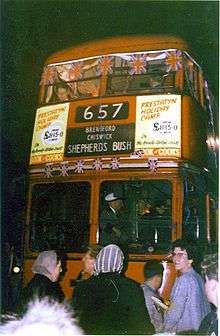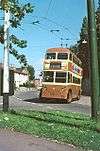Trolleybuses in London
Trolleybuses served the London Passenger Transport Area from 1931 until 1962. For much of its existence, the London system was the largest in the world. It peaked at 68 routes, with a maximum fleet of 1,811 trolleybuses.[1][2]
| London trolleybus system | |
|---|---|
| Operation | |
| Locale | London, England |
| Open | 16 May 1931 |
| Close | 8 May 1962 |
| Status | Closed |
| Routes | 68 |
| Operator(s) | London United Tramways (1931–1933) London Passenger Transport Board (1933–1947) London Transport Executive (1947–1962) |
| Infrastructure | |
| Electrification | |
| Stock | 1,811 (maximum) |
History


London's first 60 trolleybuses were introduced by London United Tramways (LUT), operating from Fulwell bus garage in South-West London. They were nicknamed "Diddlers" and commenced running on 16 May 1931.[1][3]
In 1933, LUT was absorbed into the London Passenger Transport Board (LPTB) along with other tram operators. The LPTB decided to replace all trams with trolleybuses. This started in October 1935 with two more former LUT routes, and continued in stages until June 1940, when World War II caused the suspension of the program. By then, nearly all the trams North of the River Thames had been replaced, however there were still some 1,100 trams servicing South London.[4] In 1946, a change in policy meant that all remaining tramlines would be replaced by diesel buses. As trolleybuses were bigger than diesel buses (70 seats compared to 56), this meant that more diesel buses were required. It was hoped, however, that this would result in fewer uncollected fares on the smaller vehicles.
In 1948, a new batch of 77 trolleybuses replaced the Diddlers, and those which had been destroyed by enemy action. A further 50 new trolleybuses were delivered in 1952 to replace the oldest vehicles, which were then 16 years old.
In 1954, it was announced that all trolleybuses were to be replaced by diesel buses, with the exception of the post-war vehicles, which would be retained until about 1970 and run over the original LUT routes. Conversion began in 1959, using AEC Regent III RT buses for the first three stages, and new AEC Routemasters for the remainder.[5][6]
A consortium of Spanish operators bought the post-war vehicles. The former LUT routes were the last to be converted to diesel buses, on 8 May 1962.[1][2][3][7]
Fleet
The trolleybuses were designed and built specifically to be worthy tram replacements. Like the trams, they were large high-capacity double deckers, with rapid acceleration. All but one had three axles (necessary as they were 30 feet long), and were much quieter in operation than contemporary trams or diesel buses.[8] Trolleybuses were built on AEC, Leyland and British United Traction chassis.[9]
Apart from the Diddlers and a few experimental vehicles, most London trolleybuses were near-identical. There was an exception: in 1941 and 1943 London Transport acquired 43 trolleybuses that had been ordered for South Africa but could not be shipped there because of the war.[10] These vehicles were allocated to Ilford depot. They formed three different classes and needed special dispensation because they were eight feet wide, six inches more than the law allowed.
Some later pre-war vehicles made use of modern monocoque construction techniques to produce chassisless bodies, where the mechanical and electrical parts, including the traction motors, are affixed to the bodywork and not to a separate chassis.
One experimental vehicle was proposed to be the forerunner of a fleet that would use the Kingsway tramway subway, but the change of policy after the war meant that this was never carried out.
A handful of vehicles were destroyed during World War II, whilst a couple of dozen others were rebuilt after suffering damage from enemy action—at least one trolleybus was damaged and rebuilt twice.
The Q1 class were the only trolleybuses built for London after the War. A handful of pre-war vehicles were sold for further use in Penang (Malaysia), while most of the post-war ones were exported to Spain where they worked for various operators—some into the 1970s.
Some London trolleybuses are now preserved in the United Kingdom by the East Anglia Transport Museum, the London Transport Museum, and The Trolleybus Museum at Sandtoft.[11] One of the 1948 vehicles has also been repatriated from Spain.
| Class | Fleet No. | Comments |
|---|---|---|
| A1 | 1 to 35 | "Diddlers"; No.1 preserved (London Transport Museum) |
| A2 | 36 to 60 | "Diddlers" |
| X1 | 61 | Experimental Pay As You Board, centre door only |
| X2 | 62 | Lengthened wheelbase |
| X3 | 63 | London's only 4-wheel trolleybus |
| B | 64 to 93 | |
| B2 | 94 to 131 | |
| C1 | 132 to 183 | |
| C2 | 184 to 283 | No.260 preserved (East Anglia Transport Museum) |
| C3 | 284 to 383 | |
| D1 | 384 | |
| D2 | 385 to 483 | |
| B | 484 to 488 | |
| B1 | 489 to 493 | |
| D3 | 494 to 553 | |
| E | 554 to 603 | |
| E2 | 604 to 628 | |
| E3 | 629 to 653 | |
| F1 | 654 to 753 | |
| X4 | 754 | Experimental Pay As You Enter (rear door) front exit, both fitted with folding doors |
| H1 | 755 to 904 | No.796 preserved (East Anglia Transport Museum) |
| J1 | 905 to 952 | |
| M | 953 | |
| L2 | 954 | |
| J2 | 955 to 1029 | |
| J3 | 1030 to 1054 | |
| K1 | 1055 to 1154 | |
| K2 | 1155 to 1254 | No.1201 preserved (East Anglia Transport Museum) |
| K1 | 1255 to 1304 | No.1253 preserved (London Transport Museum) |
| K2 | 1305 to 1354 | No.1348 preserved (Trolleybus Museum at Sandtoft) |
| L1 | 1355 to 1369 | |
| L2 | 1370 to 1378 | |
| X5 | 1379 | Experimental (modified class L2) with off-side doors to test the suitability of operating trolleybuses through the Kingsway tramway subway |
| L3 | 1380 to 1529 | No.1521 preserved (East Anglia Transport Museum) |
| M1 | 1530 to 1554 | |
| N1 | 1555 to 1644 | |
| N2 | 1645 to 1669 | |
| X6 | 1670 | |
| X7 | 1671 | Tandem steering, single rear axle (dual wheels) drive; built as a Leyland demonstrator, February 1939, acquired September 1939 |
| K3 | 1672 to 1696 | |
| P1 | 1697 to 1721 | |
| SA1 | 1722 to 1733 | 8'0" wide bodies |
| SA2 | 1734 to 1746 | 8'0" wide bodies |
| SA3 | 1747 to 1764 | 8'0" wide bodies |
| Q1 | 1765 to 1891 | 8'0" wide bodies; No.1768 preserved (London Transport Museum); No.1812 preserved (Trolleybus Museum at Sandtoft) |
List of routes
At its peak, the network was the largest in the world, running 68 routes. The following is a list of the routes that were withdrawn in the replacement programme which ran from 1959 to 1962.[12][13]
- 513: Hampstead Heath - Parliament Hill Fields
- 517: North Finchley - Holborn
- 521: Holborn - North Finchley
- 543: Holborn - Wood Green
- 555: Bloomsbury - Leyton
- 557: Chingford Mount - Liverpool Street
- 567: Barking - Smithfield
- 569: Aldgate - North Woolwich
- 581: Bloomsbury - Woodford
- 601: Twickenham - Tolworth
- 602: Dittons - Kingston loop
- 603: Tolworth - Kingston loop
- 604: Hampton Court Palace - Wimbledon
- 605: Teddington - Wimbledon
- 607: Uxbridge - Shepherds Bush
- 609: Barnet - Highgate
- 609: Moorgate - Barnet
- 611: Highgate Village - Moorgate
- 613: Parliament Hill Fields - Holborn
- 615: Parliament Hill Fields - Moorgate
- 617: North Finchley - Holborn
- 621: Holborn - North Finchley
- 623: Woodford - Manor House
- 625: Woodford - Winchmore Hill
- 626: Acton - Clapham Junction
- 627: Waltham Cross - Tottenham Court Road
- 628: Craven Park - Clapham Junction
- 629: Enfield - Tottenham Court Road
- 630: Harlesden - West Croydon
- 639: Hampstead - Moorgate
- 641: Moorgate - Winchmore Hill
- 643: Holborn - Wood Green
- 645: Canons Park - Barnet
- 647: Stamford Hill - London Docks
- 649: Waltham Cross - Liverpool Street station
- 649A: Wood Green - Liverpool Street station
- 653: Aldgate - Tottenham Court Road
- 654: Sutton - Crystal Palace
- 655: Acton Vale - Clapham Junction
- 657: Hounslow - Shepherds Bush
- 659: Waltham Cross - Holborn
- 660: North Finchley - Hammersmith
- 661: Aldgate - Leyton
- 662: Sudbury - Paddington Green
- 663: Aldgate - Chadwell Heath
- 665: Barking - Bloomsbury
- 666: Edgware - Hammersmith
- 667: Hammersmith - Hampton Court
- 669: North Woolwich - Stratford
- 677: Smithfield - West India Docks
- 679: Waltham Cross - Smithfield
- 685: North Woolwich - Walthamstow
- 687: Walthamstow - Royal Victoria and Albert docks
- 689: Stratford - East Ham circular via Plashet Grove & Green Street
- 690: Stratford - East Ham circular via Green Street & Plashet Grove
- 691: Barking - Barkingside
- 693: Barking - Chadwell Heath
- 696: Woolwich - Dartford
- 697: Chingford Mount - Docks
- 698: Woolwich - Bexleyheath
- 699: Chingford Mount - Docks
In July 1990, London Regional Transport introduced an express version of bus route 207 as route 607 between Uxbridge and Shepherds Bush, mirroring the former trolleybus that carried the same number.
Proposed revival
In 2012, it was proposed that a trolleybus based on the New Routemaster be introduced to address pollution concerns on Oxford Street.[14]
References
Notes
- Murray, Alan (2000). World Trolleybus Encyclopaedia, p. 73. Yateley, Hampshire, UK: Trolleybooks. ISBN 0-904235-18-1.
- Short, Peter. "Former UK systems". British Trolleybus Society. Retrieved 16 March 2011.
- Joyce, J.; King, J. S.; and Newman, A. G. (1986). British Trolleybus Systems, pp. 84–95, 159. London: Ian Allan Publishing. ISBN 0-7110-1647-X.
- London Trolleybus Routes, Hugh Taylor, Capital Transport, 1994
- Farewell to London's Trolleybuses, Michael H C Baker. Ian Allan Publishing, 1994
- London Trolleybuses to Go Commercial Motor 7 May 1954
- Last of London's trolleybuses Commercial Motor 13 April 1962
- "Trolleybus (1981/528)". London Transport Museum website. Retrieved 16 March 2011.
- Preserved British Trolleybus Fleet List trolleybus.co.uk
- South African Trolleybuses for London Commercial Motor 14 November 1941
- Zebedee, John (30 November 2010). "A List of Preserved Trolleybuses in the UK". British Trolleybus Society. Retrieved 16 March 2011.
- Hugh Taylor (1994), London Trolleybus Routes, Capital Transport, ISBN 9781854141552
- Trolley Bus Replacement program 1959 - 1962 London Buses
- Return of the trolleybus Autocar 18 December 2012
Bibliography
- Blacker, Ken (2002). The London Trolleybus. Volume 1: 1931–1945. Harrow: Capital Transport. ISBN 978-1-85414-260-3.
- Blacker, Ken (2004). The London Trolleybus. Volume 2: 1946–1962. Harrow: Capital Transport. ISBN 978-1-85414-285-6.
- Fairhurst, Doug (2014). A London Trolleybus Experience. Clophill, Bedfordshire, UK: Irwell Press. ISBN 9781906919672.
- Russell, Terry (1996). Croydon Trolleybuses. Midhurst, West Sussex, UK: Middleton Press. ISBN 9781873793732.
- Taylor, Hugh (1994). London Trolleybus Routes. Middlesex: Capital Transport Publishing. ISBN 978-1-85414-155-2.
- Taylor, Hugh (2006). London Trolleybuses - A Class Album. Harrow: Capital Transport. ISBN 978-1-85414-302-0.
- Webber, Mick (1997). London Trolleybus Chronology 1931-1962. Shepperton: Ian Allan. ISBN 0-7110-2528-2.
- Webber, Mick (2009). London Trolleybuses - a black and white album. Harrow: Capital Transport. ISBN 978-1-85414-333-4.
- Wyatt, Charlie (2008). Beneath the Wires of London. Harrow: Capital Transport. ISBN 978-1-85414-325-9.
